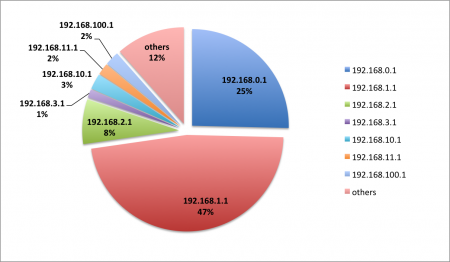Least popular 192.168 networks
Having a home VPN server on the default 192.168.1.0 subnet is a pain due to address collisions. Indeed, if I haven’t bothered to change it before, why should I expect a random cyber cafe/hotel/company or anyone at all to use a different default subnet?
So I’ve decided to renumber my home network. But first, I wanted to find a 192.168.x.0/24 subnet with the lowest popularity, so I could minimize the potential collisions.
I asked Google1, querying all the default gateways2 of the form “192.168.x.1”, and got the following result (x axis is the number of Google results, in log scale). Click to enlarge.
Keep in mind that the Google AJAX search API used here returns somewhat strange numbers, which are by a factor of 10 lower than in plain old desktop Google search, but at least that factor appears to be consistent (I checked the first 10 IPs).
In fact, the data here is not intuitively comprehensible. The pie chart below is better, showing that anything except the 7 subnets in the legend should give you a sufficiently low probability of collision (lower than 1%). Click to enlarge.
Note: all data as of Nov 14 2012. Here’s the raw dataset.
But renumbering the network is a lot of work, really, so maybe I should just pick something from the 10 or 172 subnets. These seem to be much rarer (especially 172). Of course I’d have to retrain my muscle memory.
There’s other options as well, but I don’t find them very practical. For example, using a 1:1 NAT to provide additional address mapping to VPN users just complicates the network, not to mention firewall rules. And using static client side routes is another non-option, since it can’t be used on locked down devices, such as iPhones and iPads. So renumbering it is.
- I used Google AJAX Search API, stuck the URL into a Ruby script and iterated from 0 to 254 [↩]
- I made two hopefully reasonable assumptions, namely that the network popularity is proportional to the amount of people talking about its default gateway, and that the default gateway is has the .1 address [↩]


Reply
You must be logged in to post a comment.